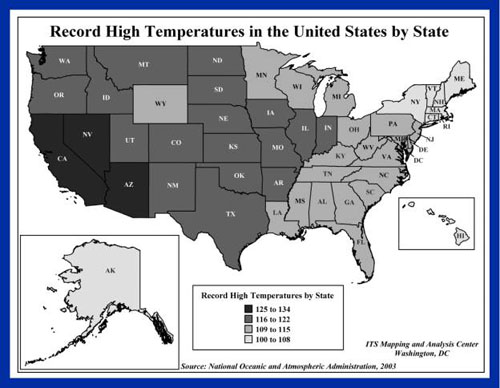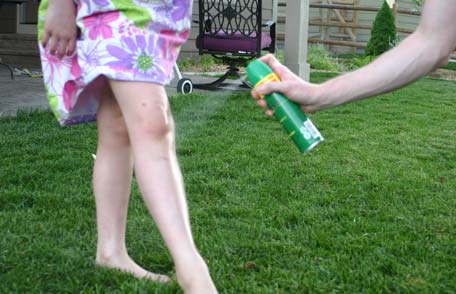
Heat kills by pushing the human body beyond its limits. In extreme heat and high humidity, evaporation is slowed and the body must work extra hard to maintain a normal temperature.
Most heat disorders occur because the victim has been overexposed to heat or has over-exercised for his or her age and physical condition. Older adults, young children, and those who are sick or overweight are more likely to succumb to extreme heat.
Conditions that can induce heat-related illnesses include stagnant atmospheric conditions and poor air quality. Consequently, people living in urban areas may be at greater risk from the effects of a prolonged heat wave than those living in rural areas. Also, asphalt and concrete store heat longer and gradually release heat at night, which can produce higher nighttime temperatures known as the urban heat island effect.
Know the Terms
Familiarize yourself with these terms to help identify an extreme heat hazard:
Heat Wave Prolonged period of excessive heat, often combined with excessive humidity.
Heat Index A number in degrees Fahrenheit (F) that tells how hot it feels when relative humidity is added to the air temperature. Exposure to full sunshine can increase the heat index by 15 degrees.
Heat Cramps Muscular pains and spasms due to heavy exertion. Although heat cramps are the least severe, they are often the first signal that the body is having trouble with the heat.
Heat Exhaustion Typically occurs when people exercise heavily or work in a hot, humid place where body fluids are lost through heavy sweating. Blood flow to the skin increases, causing blood flow to decrease to the vital organs. This results in a form of mild shock. If not treated, the victims condition will worsen. Body temperature will keep rising and the victim may suffer heat stroke.
Heat Stroke (Sun Stroke) A life-threatening condition. The victims temperature control system, which produces sweating to cool the body, stops working. The body temperature can rise so high that brain damage and death may result if the body is not cooled quickly.
Take Protective Measures
Before Extreme Heat
To prepare for extreme heat, you should:
- Install window air conditioners snugly; insulate if necessary.
- Check air-conditioning ducts for proper insulation.
- Install temporary window reflectors (for use between windows and drapes), such as aluminum foil-covered cardboard, to reflect heat back outside.
- Weather-strip doors and sills to keep cool air in.
- Cover windows that receive morning or afternoon sun with drapes, shades, awnings, or louvers. (Outdoor awnings or louvers can reduce the heat that enters a home by up to 80 percent.)
- Keep storm windows up all year.
During a Heat Emergency

The following are guidelines for what you should do if the weather is extremely hot:
- Stay indoors as much as possible and limit exposure to the sun.
- Stay on the lowest floor out of the sunshine if air conditioning is not available.
- Consider spending the warmest part of the day in public buildings such as libraries, schools, movie theaters, shopping malls, and other community facilities. Circulating air can cool the body by increasing the perspiration rate of evaporation.
- Eat well-balanced, light, and regular meals. Avoid using salt tablets unless directed to do so by a physician.
- Drink plenty of water. Persons who have epilepsy or heart, kidney, or liver disease; are on fluid-restricted diets; or have a problem with fluid retention should consult a doctor before increasing liquid intake.
- Limit intake of alcoholic beverages.
- Dress in loose-fitting, lightweight, and light-colored clothes that cover as much skin as possible.
- Protect face and head by wearing a wide-brimmed hat.
- Check on family, friends, and neighbors who do not have air conditioning and who spend much of their time alone.
- Never leave children or pets alone in closed vehicles.
- Avoid strenuous work during the warmest part of the day. Use a buddy system when working in extreme heat, and take frequent breaks.
First Aid for Heat-Induced Illnesses

Extreme heat brings with it the possibility of heat-induced illnesses. The following table lists these illnesses, their symptoms, and the first aid treatment.
| Condition | Symptoms | First Aid |
|---|---|---|
| Sunburn | Skin redness and pain, possible swelling, blisters, fever, headaches | Take a shower using soap to remove oils that may block pores, preventing the body from cooling naturally. Apply dry, sterile dressings to any blisters, and get medical attention. |
| Heat Cramps | Painful spasms, usually in leg and abdominal muscles; heavy sweating | Get the victim to a cooler location. Lightly stretch and gently massage affected muscles to relieve spasms. Give sips of up to a half glass of cool water every 15 minutes. (Do not give liquids with caffeine or alcohol.) Discontinue liquids, if victim is nauseated. |
| Heat Exhaustion | Heavy sweating but skin may be cool, pale, or flushed. Weak pulse. Normal body temperature is possible, but temperature will likely rise. Fainting or dizziness, nausea, vomiting, exhaustion, and headaches are possible. | Get victim to lie down in a cool place. Loosen or remove clothing. Apply cool, wet clothes. Fan or move victim to air-conditioned place. Give sips of water if victim is conscious. Be sure water is consumed slowly. Give half glass of cool water every 15 minutes. Discontinue water if victim is nauseated. Seek immediate medical attention if vomiting occurs. |
| Heat Stroke ( a severe medical emergency) |
High body temperature (105+); hot, red, dry skin; rapid, weak pulse; and rapid shallow breathing. Victim will probably not sweat unless victim was sweating from recent strenuous activity. Possible unconsciousness. | Call 9-1-1 or emergency medical services, or get the victim to a hospital immediately. Delay can be fatal. Move victim to a cooler environment. Removing clothing Try a cool bath, sponging, or wet sheet to reduce body temperature. Watch for breathing problems. Use extreme caution. Use fans and air conditioners. |
Publications
National Weather Service Heat Wave: A Major Summer Killer. An online brochure describing the heat index, heat disorders, and heat wave safety tips.
 Print
Print Email
Email







